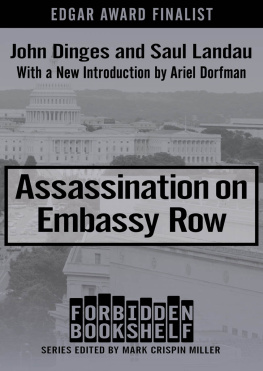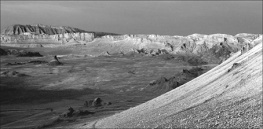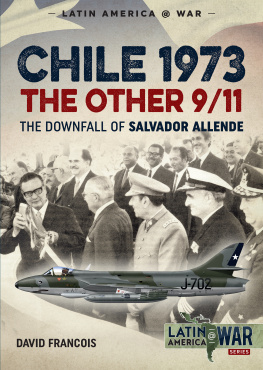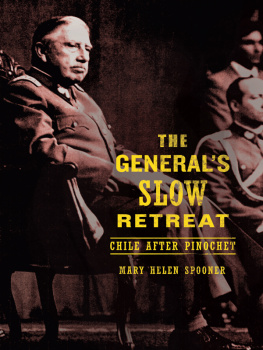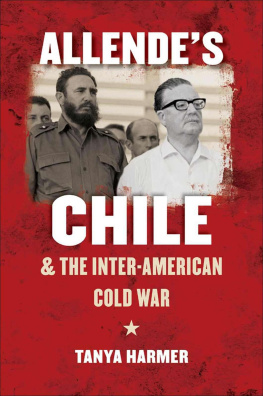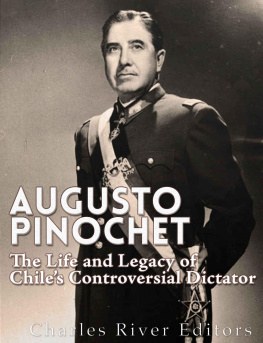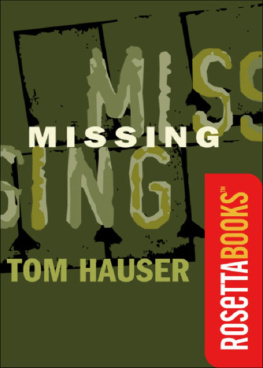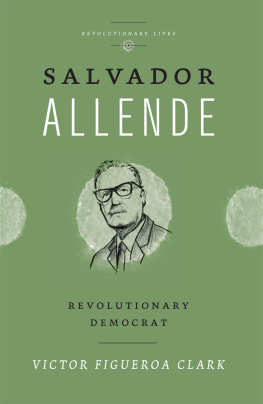THE CONDOR YEARS
THE CONDOR YEARS
Also by John Dinges
Assassination on Embassy Row (with Saul Landau)
Our Man in Panama: The Shrewd Rise and Brutal Fall of Manuel Noriega
THE CONDOR YEARS
How Pinochet and His Allies Brought
Terrorism to Three Continents
John Dinges

2004 by John Dinges
Afterword 2005 by John Dinges
All rights reserved.
No part of this book may be reproduced, in any form, without written permission from the publisher.
Requests for permission to reproduce selections from this book should be mailed to:
Permissions Department, The New Press, 38 Greene Street, New York, NY 10013
Published in the United States by The New Press, New York, 2004
Distributed by W. W. Norton & Company, Inc., New York
Extract from Pablo Nerudas Vienen los pjaros from Canto General is reprinted by permission of Fundacin Pablo Neruda, 1950 by Pablo Neruda and Fundacin Pablo Neruda
LIBRARY OF CONGRESS CATALOGING-IN-PUBLICATION DATA
Dinges, John, 1941
The Condor years : how Pinochet and his allies brought terrorism to three continents /
John Dinges.
p. cm.
Includes bibliographical references and index.
ISBN 978-1-5955-8902-6
1. ChilePolitics and government19731988. 2. Southern Cone of South AmericaPolitics and government. 3. Pinochet Ugarte, Augusto. 4. Operacin Cndor (South American countersubversion association) 5. Chile. Direccin de Inteligencia Nacional. 6. State-sponsored terrorismHistory20th century. 7. Victims of state-sponsored terrorismHistory20th century. 8. ChileRelationsForeign countries. 9. United StatesMilitary policy. I. Title
F3100.D565 2004
327.1283'009'047dc22 2003060265
The New Press was established in 1990 as a not-for-profit alternative to the large, commercial publishing houses currently dominating the book publishing industry.
The New Press operates in the public interest rather than for private gain, and is committed to publishing, in innovative ways, works of educational, cultural, and community value that are often deemed insufficiently profitable.
www.thenewpress.com
Composition by dix!
2 4 6 8 10 9 7 5 3 1
CONTENTS
On a clear September morning in 1976, Orlando Letelier, an influential former Chilean ambassador to Washington, lay dead and mutilated at Sheridan Circle on Washingtons Embassy Row, his car blown apart by a remote-control bomb. Only a few months earlier, death squads in Argentina kidnapped and executed a former president of Bolivia and two of Uruguays most prominent political leaders. Top-ranking guerrilla leaders from Chile and Uruguay, living underground in Argentina, were also tracked down and killed. Assassination squads landed in European capitals with lists of Latin American exiles. A U.S. congressman was the intended target of one of the plots.
Over a short period of several years an extraordinary list of military and political leaders from the countries of southern South America lost their lives or were targeted for assassination. The victims and targets had this in common: they opposed the anti-Communist military dictatorships that controlled much of Latin America, and they were living in what they thought was safe exile outside their own countries. Some had resorted to violence themselves; most were of the caliber and prominence that qualified them as democratic alternatives to the military strongmen they were striving to remove. In all cases the military governments had come to power with the firm support of the United States, and in all cases it was the military leaders, often working in close collaboration with one another, who organized the assassination teams and sent them on their terrorist missions.
Yet these international crimes were only a small part of the thousands upon thousands of other murders committed by the military governments in South America against their own citizens in these few yearsfrom 1973 to 1980which I have called the Condor Years. The governments claimed their enemies were terrorists. While some of them did fit the description, the most prominent victims were respected military and civilian leaders trying to preserve or restore democracy. The vast majority were educated young men and women involved in movements to challenge economic and social injustice. Their deaths are the still-uncounted collateral damage in our hemisphere of the world Cold War to vanquish the Soviet Union and the prospect of Socialist revolution.
The political tragedy of this story is that the military leaders who carried out the assassinations and mass murders looked to the United States for technical assistance and strategic leadership. The U.S. government was the ally of the military regimes. The tragedy is the United States acted not to promote and nurture democracy, but to encourage and justify its overthrow. Even more tragic, and arguably criminal, were the cases in which U.S. officials were directly involved in plots and liaison relationships with those engaged in political assassination and mass murder.
These are not charges that can be made lightly. The story is not simple or one-dimensional. Many U.S. officials were discovering human rights as a policy goal during these years, and there are examples that will be documented in this book of the CIA and other agencies trying to prevent international political assassinations. Yet U.S. diplomats, intelligence personnel, and military officers were also so intimately associated with the military institutions carrying out the repression that that they did little or nothing to discourage the massive human rights crimes about which they were reporting to Washington.
The evidence shows that the messages in favor of human rights and democracy were muted in comparison with the clarion calls to stop Communism at any cost. The signals were mixed at best. They were cynical and intentionally ambiguous at worst. The military rulers appear to have looked at U.S. actions and understood, not unreasonably, that their methods would not be opposed. (Even after the Carter administration made human rights a forceful priority in 1977, the mass killing continued in Argentina.) This book attempts to tell some of the stories of these terror-filled years from the point of view of the covert actorsinside the military governments and their international allies, including the United States, and inside the radical revolutionary groups who were their adversaries.
September 11, 1973, Santiago, Chile, is a good place to begin. It was the day General Augusto Pinochet Ugarte bombed the presidential palace, the symbol of the continents longest lasting democracy. Pinochets military coup was warmly embraced by the United States government. The official story, backed by the available evidence, is that the United States was not directly involved. Nevertheless, the same kind of official evidence shows the United States taking the lead in organizing a military uprising only three years earlier. That effort failed, but resulted in the assassination of General Ren Schneider, the leader of the Chilean armed forces. Both the 1970 U.S.backed attempt and the 1973 Pinochet coup had the same target: Salvador Allende, a Socialist who had been elected president in impeccable democratic elections.
Where the CIA-organized coup plot failed, Pinochet succeeded. Massive military force quickly smashed Allendes popular but faltering revolution. Allende himself committed suicide rather than surrender to Pinochet after his palace was bombed.
It is a coincidence that September 11 would gain even greater infamy with the World Trade Center bombings in 2001. But the coincidence is not insignificant. The first September 11 was a day after which everything changed in Latin America. Pinochets coup was not just another military takeover, of which there had been dozens in previous decades. It was the beginning of a total war justified as a war on terrorism, whose principal targets were the political forces perceived by Pinochet and his allies as infecting their countries with the alien cancer of Communist revolution.


